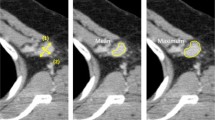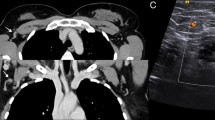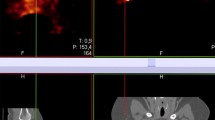Abstract
Background
In recent years, the surgical management of patients with breast cancer has shifted to a locoregional approach, and evaluating the patient’s axillary lymph node status is of the greatest importance in determining the appropriate treatment strategy. We evaluated on the efficacy of preoperative axillary staging using contrast-enhanced computed tomography (CE-CT).
Methods
Between 2000 and 2003, 235 patients with operable breast cancer who underwent CE-CT before surgery and 137 patients who received neoadjuvant chemotherapy (NAC) and underwent CE-CT before NAC and surgery were enrolled in this study. The axillary status was evaluated based on three criteria (short-axis diameter, shape, and enhancement type), and the diagnosis was correlated with the histopathological results.
Results
In patients who did not receive NAC, the size criterion of a short-axis diameter of more than 5 mm provided a sensitivity of 78%, a specificity of 75%, and an accuracy of 76% in predicting node-positive status. According to the size criterion of a short-axis diameter of more than 5 mm and the shape criterion of the absence of intranodal fat density, the specificity and accuracy were 90% and 81%, respectively, and according to the enhancement type criterion of early enhancement, the corresponding values were 89% and 78%. Evaluation was more difficult in patients who received NAC and the sensitivity of the size-based criterion in the patients who received NAC was lower than in those who did not.
Conclusion
These findings suggest that CE-CT based on size criteria is useful for evaluating the preoperative axillary status of breast cancer patients, but that evaluation is more difficult and the sensitivity is reduced in patients who have received NAC.
Similar content being viewed by others
References
Akashi-Tanaka S, Fukutomi T, Sato N, et al. (2004) The use of contrast-enhanced computed tomography before neoadjuvant chemotherapy to identify patients likely to be treated safely with breast-conserving surgery. Ann Surg 239:238–243
Akashi-Tanaka S, Fukutomi T, Miyakawa K, et al. (1998) Diagnostic value of contrast-enhanced computed tomography for diagnosing the intraductal component of breast cancer. Breast Cancer Res Treat 49:79–86
Akashi-Tanaka S, Fukutomi T, Watanabe T, et al. (2001) Accuracy of contrast-enhanced computed tomography in the prediction of residual breast cancer after neoadjuvant chemotherapy. Int J Cancer 96:66–73
Okuyama N, Murakuni H, Ogata H (2004) The use of Doppler ultrasound in evaluation of breast cancer metastasis to axillary lymph nodes. Oncol Rep 11:389–393
Loehberg CR, Lux MP, Ackermann S, et al. (2005) Neoadjuvant chemotherapy in breast cancer: which diagnostic procedures can be used? Anticancer Res 25:2519–2526
Khan A, Sabel MS, Nees A, et al. (2005) Comprehensive axillary evaluation in neoadjuvant chemotherapy patients with ultrasonography and sentinel lymph node biopsy. Ann Surg Oncol 12:697–704
Ogawa Y, Nishioka A, Nishihgawa T, et al. (2003) Thin-section CT evaluation and pathologic correlation of therapeutic nodes of clinically node-positive breast cancer patients. Oncol Rep 10:985–989
Hata Y, Ogawa Y, Nishioka A, et al. (1998) Thin section computed tomography in the prone position for detection of axillary lymph node metastasis in breast cancer. Oncol Rep 5:1403–1406
Yuen S, Sawai K, Ushijima Y, et al. (2002) Evaluation of axillary status in breast cancer. CT-based determination of sentinel lymph node size. Acta Radiol 43:579–586
Yuen S, Yamada K, Goto M, et al. (2004) CT-based evaluation of axillary sentinel lymph node status in breast cancer: value of added contrast-enhanced study. Acta Radiol 45:730–737
Miyauchi M, Yamamoto N, Imanaka N, et al. (1999) Computed tomography for preoperative evaluation of axillary nodal status in breast cancer. Breast Cancer 6:243–248
Kvistad KA, Rydland J, Smethrust HB, et al. (2000) Axillary lymph node metastases in breast cancer: preoperative detection with dynamic contrast-enhanced MRI. Eur Radiol 10:1464–1471
Lernevall A (2000) Imaging of axillary lymph nodes. Acta Oncol 39:276–281
Michel SCA, Keller TM, Frohlich JM, et al. (2002) Preoperative breast cancer staging: MR imaging of the axilla with ultrasmall superparamagnetic iron oxide enhancement. Radiology 225:527–536
Sapino A, Cassoni P, Zanon E, et al. (2003) Ultrasonographically guided fine-needle aspiration of axillary lymph nodes: role in breast cancer management. Br J Cancer 88:702–706
Bonadonna G, Valagussa P, Brambilla C, et al. (1998) Primary chemotherapy in operable breast cancer: 8-year experience at the Milan Cancer Institute. J Clin Oncol 16:93–100
Cameron DA, Anderson EDC, Levack P, et al. (1997) Primary systemic therapy for operable breast cancer: 10-year survival data after chemotherapy and hormone therapy. Br J Cancer 76:1099–1105
Pierga JY, Mouret E, Dieras V, et al. (2000) Prognostic value of persistent node involvement after neoadjuvant chemotherapy in patients with operable breast cancer. Br J Cancer 83:1480–1487
The Japanese Breast Cancer Society (2004) General rules for clinical and pathological recording of breast cancer, 15th edn. Kanehara, Tokyo
Kamiyoshihara M, Kawashima O, Ishikawa S, et al. (2001) Mediastinal lymph node evaluation by computed tomographic scan in lung cancer. Int J Cancer 42:119–124
Georgian D, Rice TW, Mehta AC, et al. (1990) Intracystic lymph node evaluation by CT and MRI with histopathologic correlation in non-small cell bronchogenic carcinoma. Clin Imaging 14:35–40
Daly BD Jr, Faling LJ, Bite G, et al. (1987) Mediastinal lymph node evaluation by computed tomography in lung cancer. An analysis of 345 patients grouped by TMN staging, tumor size, and tumor location. J Thorac Cardiovasc Surg 94:664–672
Brady EW (2002) Sentinel lymph node mapping following neoadjuvant chemotherapy for breast cancer. Breast J 8:97–100
Piato JRM, Barros ACSD, Pincerato KM, et al. (2002) Sentinel lymph node biopsy in breast cancer after neoadjuvant chemotherapy. A pilot study. Eur J Surg Oncol 29:118–120
Kinoshita T, Takasugi M, Iwamoto E, et al. (2006) Sentinel lymph node biopsy examination for breast cancer patients with clinically negative axillary lymph nodes after neoadjuvant chemotherapy. Am J Surg 191:225–229
Cody HS 3rd (2001) Clinical aspects of sentinel node biopsy. Breast Cancer Res 3:104–108
Author information
Authors and Affiliations
Corresponding author
About this article
Cite this article
Shien, T., Akashi-Tanaka, S., Yoshida, M. et al. Evaluation of axillary status in patients with breast cancer using thin-section CT. Int J Clin Oncol 13, 314–319 (2008). https://doi.org/10.1007/s10147-007-0753-z
Received:
Accepted:
Published:
Issue Date:
DOI: https://doi.org/10.1007/s10147-007-0753-z




